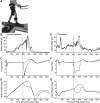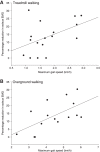Contribution of sensory feedback to plantar flexor muscle activation during push-off in adults with cerebral palsy
- PMID: 28904105
- PMCID: PMC5814719
- DOI: 10.1152/jn.00508.2017
Contribution of sensory feedback to plantar flexor muscle activation during push-off in adults with cerebral palsy
Abstract
Exaggerated sensory activity has been assumed to contribute to functional impairment following lesion of the central motor pathway. However, recent studies have suggested that sensory contribution to muscle activity during gait is reduced in stroke patients and children with cerebral palsy (CP). We investigated whether this also occurs in CP adults and whether daily treadmill training is accompanied by alterations in sensory contribution to muscle activity. Seventeen adults with CP and 12 uninjured individuals participated. The participants walked on a treadmill while a robotized ankle-foot orthosis applied unload perturbations at the ankle, thereby removing sensory feedback naturally activated during push-off. Reduction of electromyographic (EMG) activity in the soleus muscle caused by unloads was compared and related to kinematics and ankle joint stiffness measurements. Similar measures were obtained after 6 wk of gait training. We found that sensory contribution to soleus EMG activation was reduced in CP adults compared with uninjured adults. The lowest contribution of sensory feedback was found in participants with lowest maximal gait speed. This was related to increased ankle plantar flexor stiffness. Six weeks of gait training did not alter the contribution of sensory feedback. We conclude that exaggerated sensory activity is unlikely to contribute to impaired gait in CP adults, because sensory contribution to muscle activity during gait was reduced compared with in uninjured individuals. Increased passive stiffness around the ankle joint is likely to diminish sensory feedback during gait so that a larger part of plantar flexor muscle activity must be generated by descending motor commands.NEW & NOTEWORTHY Findings suggest that adults with cerebral palsy have less contribution of sensory feedback to ongoing soleus muscle activation during push-off than uninjured individuals. Increased passive stiffness around the ankle joint is likely to diminish sensory feedback during gait, and/or sensory feedback is less integrated with central motor commands in the activation of spinal motor neurons. Consequently, muscle activation must to a larger extent rely on descending drive, which is already decreased because of the cerebral lesion.
Keywords: cerebral palsy; gait; muscle activation; push-off; sensory feedback.
Copyright © 2017 the American Physiological Society.
Figures





Similar articles
-
Sensory feedback to ankle plantar flexors is not exaggerated during gait in spastic hemiplegic children with cerebral palsy.J Neurophysiol. 2014 Feb;111(4):746-54. doi: 10.1152/jn.00372.2013. Epub 2013 Nov 13. J Neurophysiol. 2014. PMID: 24225545
-
Contribution of corticospinal drive to ankle plantar flexor muscle activation during gait in adults with cerebral palsy.Exp Brain Res. 2019 Jun;237(6):1457-1467. doi: 10.1007/s00221-019-05520-3. Epub 2019 Mar 21. Exp Brain Res. 2019. PMID: 30900000
-
Contributions to the understanding of gait control.Dan Med J. 2014 Apr;61(4):B4823. Dan Med J. 2014. PMID: 24814597 Review.
-
Characterization of torque generating properties of ankle plantar flexor muscles in ambulant adults with cerebral palsy.Eur J Appl Physiol. 2019 May;119(5):1127-1136. doi: 10.1007/s00421-019-04102-z. Epub 2019 Feb 18. Eur J Appl Physiol. 2019. PMID: 30778762
-
The effect of tuning ankle foot orthoses-footwear combination on the gait parameters of children with cerebral palsy.Prosthet Orthot Int. 2013 Apr;37(2):95-107. doi: 10.1177/0309364612450706. Epub 2012 Jul 24. Prosthet Orthot Int. 2013. PMID: 22833518 Review.
Cited by
-
Animal models of developmental motor disorders: parallels to human motor dysfunction in cerebral palsy.J Neurophysiol. 2019 Sep 1;122(3):1238-1253. doi: 10.1152/jn.00233.2019. Epub 2019 Aug 14. J Neurophysiol. 2019. PMID: 31411933 Free PMC article.
-
The effect of cathodal transspinal direct current stimulation on tibialis anterior stretch reflex components in humans.Exp Brain Res. 2022 Jan;240(1):159-171. doi: 10.1007/s00221-021-06243-0. Epub 2021 Oct 22. Exp Brain Res. 2022. PMID: 34686909
-
Motor beta cortical oscillations are related with the gait kinematics of youth with cerebral palsy.Ann Clin Transl Neurol. 2020 Dec;7(12):2421-2432. doi: 10.1002/acn3.51246. Epub 2020 Nov 11. Ann Clin Transl Neurol. 2020. PMID: 33174692 Free PMC article.
-
Somatosensory deficits and neural correlates in cerebral palsy: a scoping review.Dev Med Child Neurol. 2021 Dec;63(12):1382-1393. doi: 10.1111/dmcn.14963. Epub 2021 Jun 17. Dev Med Child Neurol. 2021. PMID: 34145582 Free PMC article.
-
Increased Ankle Plantar Flexor Stiffness Is Associated With Reduced Mechanical Response to Stretch in Adults With CP.Front Bioeng Biotechnol. 2021 Mar 25;9:604071. doi: 10.3389/fbioe.2021.604071. eCollection 2021. Front Bioeng Biotechnol. 2021. PMID: 33842442 Free PMC article.
References
Publication types
MeSH terms
LinkOut - more resources
Full Text Sources
Other Literature Sources
Medical
Miscellaneous

